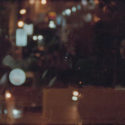Inner Landscapes
Filmography: 2019
Ocean Breath (2019 [digital])
4k video loop, 15 minutes
The installation Ocean Breath includes soundscapes of the ocean, a 4k video loop, and a 16 mm experimental short film. All the recordings were collected in Morocco in September 2019. The idea to do a work on water and breathing was inspired by a Breathcore, a chorus, which opened the Wiener Festwochen production Pneuma of the Brussels-based contemporary music ensemble Ictus in June 2019. I performed as volunteer in the Breathcore piece. For this the flutist Michael Schmid rehearsed for four days with a group of twenty performers. He made us familiar with the basic breathing techniques. Our breath resonated and created a field of respiratory soundscapes. I continued my breath work while traveling in Morocco. Inspired by Juan Rojas Routon’s research in landscape anthropology, Ocean Breath is an attempt to develop a ‘connective tissue’ between his ethnographic and my arts-based approaches. This involves finding a place where we both feel at home in terms of content and on a relationship level. Landscape in anthropological research is regarded as a sensuous material form. In my art work I am particularly interested in how I can interact with this material and how different types of landscape, for example, a coast region or an ancient forest, act on me. One way to experience the sensuous qualities, the wild breath of the sea, is to take the camera with me into the water.
Inner Landscapes (2019 [series])
Ocean Breath
16 mm, color, 18 f/s, 4 minutes
The 16 mm short film Ocean Breath opens the Inner Landscapes series of multiple exposure films that addresses sensory aspects of landscape perception. For this I experiment with the material of film and test its sensitivity. Étienne-Jules Marey describes the film material as light sensitive moving skin. He outlines that in order to capture movement on photographic images the skin needs to be cut into stripes, wound on reels, loaded into an apparatus, quickly be passed by at an opening (aperture) through which light is entering the otherwise entirely dark camera box, leaving the desired traces on the vulnerable membrane. The skin of film develops a fascinating and similarly challenging life on its own. I am particularly interested in the physicality that is inherent in the operations in filmmaking. Thus, I shift my attention from the mechanical aspects of how a camera can be operated to a more visceral and organic handling. In doing so I enter, for me, untrodden terrain. With my exercises in multiple exposure filming I put myself frequently in hardly controllable, to a certain extent, frightening situations. I expose myself to the realities of given environments.
Trees of Life
16 mm, color, 18 f/s, 4 minutes
For Trees of Life, the second part of the series Inner Landscapes, I did night shots in an ancient argan forest in the southwest of Morocco. The film is an experimental cinematic approach towards landscape anthropology. For this I use the camera as tool that allows me to literally get in touch with the materiality of nature: tree foliage, dry grey bark and thorns. It was a rather dark full moon night. The camera gaze searches for something that is kept in the mysterious darkness during the entire film. An exploration of traces. By means of multiple exposure filming the life of surfaces is being disclosed. A local accompanied me and guided me to the trees. Since I was not able to operate the Bolex camera and do the lighting at the same time, he would assist me with the light too. We shared tasks. This led to a crazy pair dance around the trees. During the shooting breaks we found ourselves sitting on stones on the ground. My hands were in the change bag in order to rewind the film.
Feeling Lost in Tangier
16 mm, color, 18 f/s, 4 minutes
The third, for the time being, last part of the Inner Landscapes series is dedicated to the night life in Tangier, Morocco. For this the camera accompanied me on my way through the medina late at night. This is the most personal film of the series. In Feeling Lost in Tangier, I touch deeply hidden memories inside of me. My body still recalls those traumata in certain situations. I easily feel lost, fall into a stupor. My sense of orientation, of time and space, is impaired. Feelings of disorientation and loneliness are brought to the fore. The film is an attempt to articulate the dark emptiness I occasionally experience while I desperately try to find my way. Memories of a place I have never been to.
Acknowledgements:
I would like to thank all of my countless collaboration partners, patients, surgeons, anesthetists, scrub nurses, my colleagues in the social sciences and visual arts, and, last but not least, people of the local communities I visited during my travels! Without them, my research and artwork would be impossible. The research project Visceral Operations / Assemblage is funded by the Austrian Science Fund (FWF). Thank you!
Inner Landscapes (2019): https://vimeo.com/375083531
Ocean Breath (2019): https://vimeo.com/372176548
Trees of Life (2019): https://vimeo.com/372177126
Feeling Lost in Tangier (2019): https://vimeo.com/372166673
Password: corporealities
